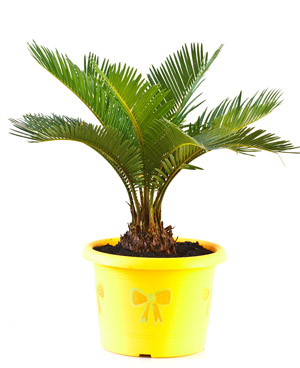Indoor sago palm Bigstock

Also known as cycad palms, these hardy evergreen yard plants grow in warm states such as Florida, North Carolina, Georgia, Hawaii and other tropical/subtropical environments of the southern United States. Plants from this family include the Cycad (sago palm), coontie, cardboard palm, and Japanese cycad but their increased use as houseplants has resulted in their availability worldwide. All parts of the sago palm from its base, to the fruit, to the seed, are TOXIC to your dog or cat. There are male and female plants with the female plants being more toxic. Go figure! The sago palm is sold as an indoor ornamental bonsai-type houseplant or landscaping plant thereby increasing the chance of exposure by pets regardless of geographic location. So unless you’re living in Alaska, you can probably get your hands on one. You might even find one all the way up there provided it’s warm enough indoors!
Sago palms contain three nasty toxins capable of causing potentially life-threatening liver failure and central nervous system toxicity. All parts of the plant are considered poisonous, but the seeds contain the largest amount of toxin and ingesting as few as two seeds can result in your pet developing signs of illness in your pet. So if the seeds are as tasty to Fido as a Lay’s potato chip ― “betcha can’t eat just one” ― he’s probably in big trouble.
Signs of illness with sago palm toxicity can be seen within 15 minutes to several hours after ingestion. The three main organ systems affected are the GI tract, liver, and central nervous system. Signs can include: decreased appetite, vomiting with or without blood, weakness, diarrhea with or without blood, dehydration, abdominal pain, incoordination, muscle tremors, seizures, coma, and death.
Routine lab testing performed by your veterinarian can reveal evidence of sudden liver failure, blood loss, and inability of the blood to clot appropriately.
Considering that ingestion can cause serious illness, severe liver damage, and death, prompt treatment is warranted as soon as possible. So just like the pre-school child that ate too many corn-dogs at the state fair then hopped on the “tilt-a-HURL,” vomiting should be induced if your pet just recently ingested part of the plant but displays no signs of toxicity. Charcoal can be given by mouth to reduce absorption of toxins to those pets that have experienced more prolonged exposure to them. Additional therapy depends on severity and can include IV fluid support, anti-seizure medications if there is central nervous system involvement, liver protective medications, and blood products such as plasma or vitamin K if there is delayed blood clotting due to sudden liver damage and failure.
Prognosis can vary with sago palm toxicosis. Factors such as how soon ingestion is identified, how quickly vomiting is initiated if it can be at all, and how severe the pet’s signs are all play a role in the potential outcome. If liver failure is severe, prognosis is very poor to grave. The rate of death for sago palm toxicosis ranges from 32 to 50 percent in some studies. You might see some better odds gambling in Vegas! How soon death can occur depends on several factors, including how quickly the pet gets veterinary care and how much is ingested. In a pet with substantial liver damage, death could ensue within several days despite aggressive supportive care.
Take it from this veterinarian: This is not a plant you want to have in your home or on your property if you have a dog or cat. I’m sure you’ve heard someone say, “This one’s a bad seed.” Well, if you’re referring to the sago palm, it literally is. Simply put, just say NO to SAGO!